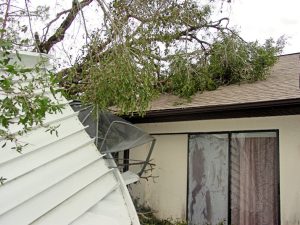
The roof is fine, you have fixed the leaning fence and the floods have receded. Your landscape is in a relative mess, but your trees are giving you some real concerns. Can you make an informed decision on what needs to happen next related to the safety of your property and the safety of other potential “targets”?
Safety is number one and many hazardous situations are obvious. Working with Tree Care Professionals and Florida Certified Arborists who have the skill and the equipment to complete most tree assessment and removal efforts is often required. Work that may take you off the ground with a chainsaw must be left to professionals. As with anybody you hire, please make sure that the person/company has insurance and references. Trees leaning on power lines, on houses, cars and laying across a road need immediate attention and likely have already been addressed by properly equipped professionals. Trees that do not need immediate attention may have fallen where there are no targets and can be reevaluated or removed later.
Tree assessment is critical as not all trees need to be cut down. For example, some small trees under four inches in diameter that were blown over and uprooted can be set upright and in effect replanted like a new tree. However, certain types of damage almost always lead to removal. Trees often break at weak connections where co-dominate stems have developed. Co-dominate stems are extra leaders that grow against each other and develop included bark. As no connection ever developed, these junctures can easily pull apart like a giant wishbone in a windstorm tearing away a large amount of the tree. The wounds which remain are often massive and never really seal up properly. Keep in mind that trees never “heal”, but instead attempt to lay down layers of wood to seal out decay organisms. By the way, do not attempt to use pruning seal on these wounds as this material can actually lock in decay organisms. If the wound is so large that it will never seal up properly, the tree may need to come down. Large wounds can decay down into the trunk and eventually cause cavities further compromising the integrity of the tree structure.
The decision on what to do with a storm-damaged trees will include some other common considerations. How much damage has occurred – how much of the canopy is gone? The larger the wound, the more likely a future decay issue. How big is the tree? A young tree has a much greater chance of growing out of its damage and can more easily be restored. As mentioned above, some small trees under four inches in diameter that were blown over can be simply stood up and staked. Any tree over eight inches in diameter is likely to become a hazard later and it is not recommended that restoration be attempted.
Which trees species do you have? Some trees are just more apt to seal up and resist decay. For example, live oaks, mahogany, and buttonwood are great at sealing up wounds. Laurel oaks and Hong Kong orchid trees are poor at sealing up wounds and are more prone to decay. Some trees such as the Laurel oak are by nature short-lived and barely have a fifty-year life span. Such trees may not be worth the restoration efforts. How healthy is the tree? A healthy tree by nature is going to snap back easier from the stress of a hurricane than one with existing decay issues and poor structure. And speaking of structure, does the tree in question have good, well- placed branches that have greater than forty-five-degree branches? Are there existing co-dominate stems? Are there big wounds from previous poor pruning practices or even topping cuts that have essentially damaged the tree? Did the tree have pre-existing site or cultural problems that led to it blowing over? Limited planting space, poor planting practices and the wrong trees that were planted in the wrong place can all contribute to the removal decision. One final thought is how valuable a tree is it? A tree of historic or sentimental nature may warrant more consideration to restoration efforts completed by an arborist.
So, when should you remove a tree? (1.) When the lower main trunk is cracked or broken. (2.) When a large stem has split from the tree, or (3.) when the tree is leaning towards a target. (4.) Remove a tree if the remainder of the tree is open to further breakage. (5.) If the major roots are broken, remove the tree as its anchorage is compromised. Additionally, (6.) remove the tree if large limbs are broken and when (7.) girdling roots have caused dead spots or trunk cracks. Don’t be too quick to take a tree down if the canopy is defoliated – in most cases the tree will send out new leaves without much problem.
Post hurricane recovery can be a trying time for both people and plants. With trees, many take-down decisions are obvious, but other cases may require some additional observations and subsequent restoration efforts. For more information on all types of tree-related topics, you can also call the Master Gardener Volunteer Helpdesk on Mondays, Wednesdays, and Fridays from 1 to 4 pm at 764-4340 for gardening help and insight into their role as an Extension volunteer. Ralph E. Mitchell is the Director/Horticulture Agent for UF/IFAS Extension – Charlotte County. He can be reached at 941-764-4344 or ralph.mitchell@charlottecountyfl.gov. Connect with us on social media. Like us on Facebook @CharlotteCountyExtension and follow us on Instagram @ifascharco.
Resources:
Kampf, E., Duryea, M. L., Gilman, E. F. & Delgado, A. (2019) Assessing Hurricane-Damaged Trees and Deciding What to do. The University of Florida Extension Service, IFAS.
Kampf, E., Duryea, M. L., Gilman, E. F. & Delgado, A. (2018) Cleaning Up after a Hurricane: Get the Right Tree Care Professional. The University of Florida Extension Service, IFAS.
 0
0
